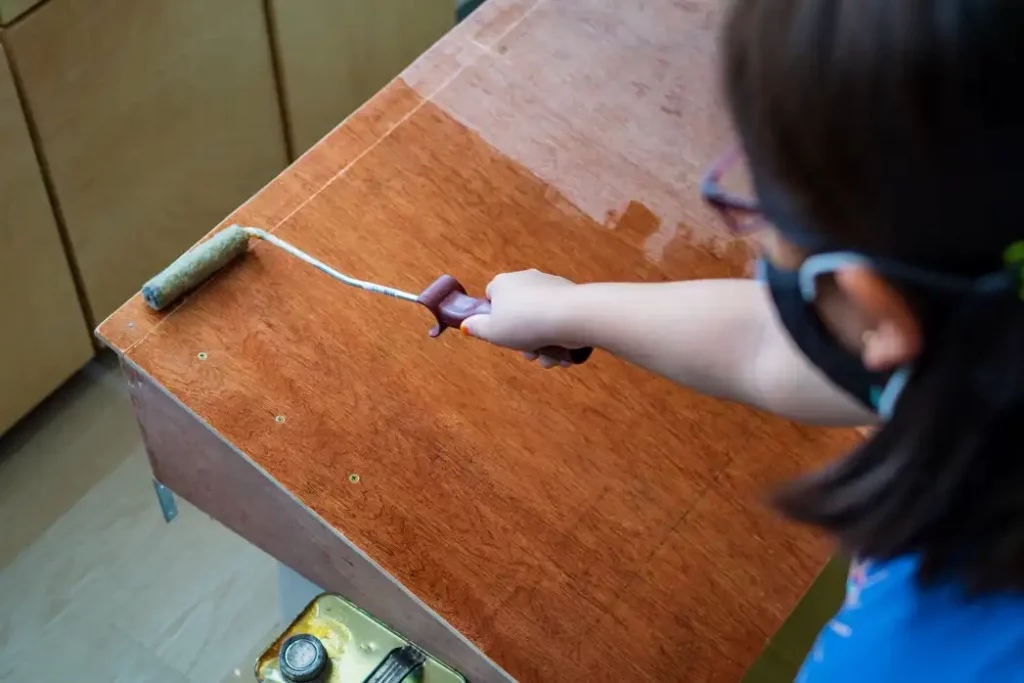Yes, polyurethane helps further the longevity of tung oil, and it is entirely compatible with dried tung oil. Tung oil also works in several varnish formulas.
Use a solvent-based poly instead of a water-based poly to achieve the golden glow of Tung oil. Over time, the solvent-based poly turns yellow/amber. In a nutshell, consider the following:
- Tung oil, for starters (probably Minwax Tung Oil)
- Allow one week for drying before sealing with clear shellac.
- Use a water-based poly after 48 hours.
To apply polyurethane over tung oil, follow these steps:
In the polyurethane, dip a fine-grit scrub sponge. Rub the finish into the wood until a light coating is applied. Allow the polyurethane to cure entirely overnight. You can use two to three coats of polyurethane, allowing each to dry for at least a day before proceeding.

Can I use water-based polyurethane over tung oil?
According to conventional thinking, you should never apply a water-based finish over an oil-based finish. You’ll probably succeed if you place shellac between the Tung Oil and the completed piece because the Tung Oil is perhaps an oil and varnish mix, but I’d test it on a scrap piece before putting it on a finished piece.
Using WB poly usually avoids an amber color; however, applying tung oil removes any benefit from the WB poly. If he wants a quick-drying finish, go with Generals Woodturner’s Finish, a mix of oil and water that dries in 2-3 minutes in low humidity. I just did a little turning, and it was dry enough for another coat by the time I finished covering it completely.
Can you put a sealer over tung oil?
Yes, you can apply a couple of coats of oil-based polyurethane for further durability, and it’ll work fine over the dried tung oil. Apply at least three coats, one each day.
On top of the tung oil, you can use e-on poly or spar varnish. The varnish should protect the top against water damage, but it will wear off after a year or two, so you’ll need to reapply it. It’s okay if it’s in your home, but not if it’s in a client’s. An epoxy finish without the tung oil would be the best option.
How to seal a tung oil finish is as follows:
Apply a thick initial coat of tung oil with a clean, dry, soft rag, a natural bristle, or a foam brush.
- After the porous surface has absorbed the first application, wait up to 40 minutes before continuing.
- Apply a second coat and allow it to seep into the surface, then repeat steps 1 and 2.
Tung oil vs polyurethane?
Polyurethane cures fast within 12 hours, which is faster than tung oil. Polyurethane rests on top of the wood in only two coats to form a watertight protective barrier. For wood floors, polyurethane always comes out on top when it comes to tung oil vs polyurethane for wood floors.
Tung oil is applied to wood with a cloth, while polyurethane is applied with a brush, sponge, or roller by woodworkers. These methods use a thicker layer of substance, which can hide rather than highlight the wood grain. As such, tung oil is a viable option for woodworkers who want to emphasize the grain of the wood. On the other hand, polyurethane isn’t great for complex woodworking like scrollwork because of the heavy patina it leaves behind.

Tips for using polyurethane over tung oil?
Some people like painted or stained furniture, while others prefer to let the wood’s natural hues come through. However, leaving the wood in its natural state does not imply that it should be left unprotected. Only coated wood with a protective layer of finish product will keep its moisture and remain soft and lovely. Tung oil and polyurethane will improve the wood’s natural tone while preventing it from becoming brittle and damaged. Provided here are some pointers on using polyurethane instead of tung oil.
1st step:
1. Put on a mask, goggles, and rubber gloves to protect yourself.
2. Dip the paint remover into an old paintbrush.
3. Paint the wood with a heavy coat of paint remover.
4. Allow 15 to 20 minutes for the stripper to soften the finish on the wood.
Step 2: Using a paint scraper, remove the wood’s original finish. To remove the finish in long strips, hold the scraper away from your body and draw it toward you. Wipe the paint residue off the bucket’s side.
Step 3: Combine 1 tbsp. Dish soap with 1 cup warm water. Soak your sponge in the water with soap and squeeze away the excess. To eliminate the chemical residue, wipe the wood. Allow the wood to air dry.
Step 4: Use a palm sander to sand a piece of fine-grit sandpaper. Using the sander, polish the surface of the wood. Remove any remnants of discoloration and apply a final coat. It would be best if you had nothing but bare wood.
Step 5: Using a towel, squirt 2 tbsp of tung oil. Wipe the tung oil into the bare wood with a soft cloth. Remove any extra oil using a damp cloth. Continue wiping away excess tung oil with a rag until the surface is saturated. Moreover, allow the oil to sink into the wood until it loses its luster. Apply two to three applications of oil to the surface.
Step 6: Using a fine grit scrub sponge, dunk the polyurethane into the sponge. Allow the polyurethane to cure entirely overnight. Now, apply two to three coats of polyurethane, allowing each to dry for at least a day before proceeding. Rub the finish into the wood until a light coating is applied.
Polyurethane over Minwax tung oil finish?
In minutes, Minwax Tung Oil Finish gives a long-lasting, hand-rubbed gloss. It is simple to maintain and is the best protective finish for restored woods since it enters wood pores and restores vitality to thirsty, dry wood. You can renew Minwax Tung Oil at any time by simply adding another coat.
Polyurethane, on the other hand, adheres to the wood’s surface. A coat of polyurethane dries in 12 hours, and only two coats of polyurethane are needed to make wood watertight. By increasing the natural wood grain, Minwax tung oil gives the wood a granular and grainy appearance. It does not coat the wood as well as polyurethane. Polyurethane is considered the best option for high-traffic surfaces like wooden flooring.
Polyurethane over watco tung oil
Watco Tung Oil Finish is a ready-to-use, fast-drying product that won’t darken over time and may be used to restore the luster and character of interior wood furniture, trim, and molding. WATCO Tung Oil Finish restores and enhances the wood’s natural color and warmth in just a few steps.
Tung Oil Finish penetrates deeply into the surface of stained and unpainted wood to provide moisture protection and the appearance of a hand-rubbed finish. As a result, the decision to use polyurethane anchors on the overall benefits provided in this article. Reapply additional coats as needed for maintenance to refresh and enhance the gloss and surface of the wood.
- Pyrography Techniques for Beginners: Textures and Shading - January 23, 2024
- Troubleshooting Jointer Issues: Why is Your Jointer Not Flattening Wood? - October 11, 2023
- Unlocking the Secrets of Jointing to Increase Width - September 29, 2023